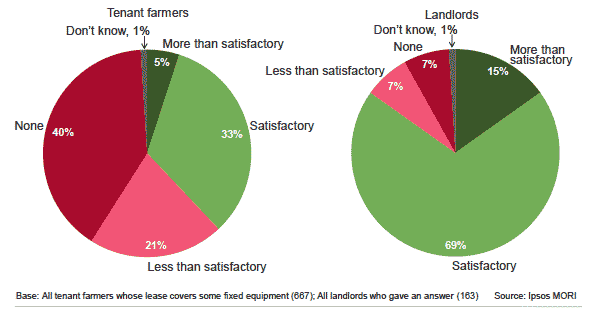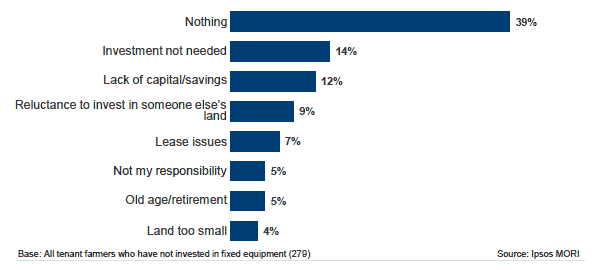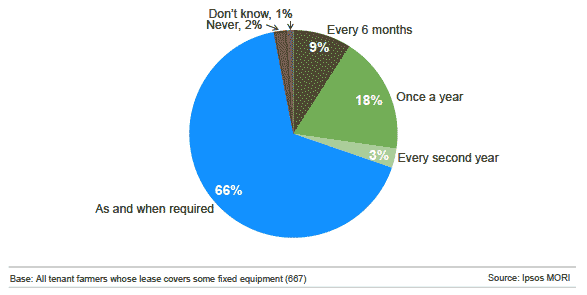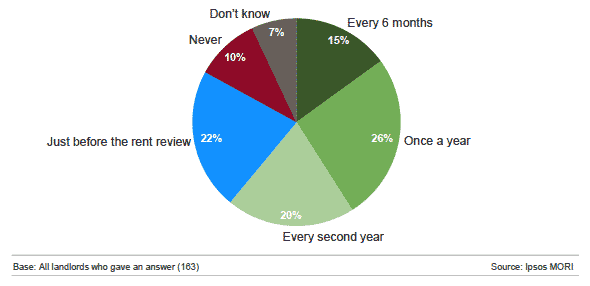Views of Tenant Farmers and Agricultural Landlords on Aspects of the Agricultural Tenancy System
Results from surveys of tenant farmers and agricultural landlords on aspects of the tenancy system such as rent review, fixed equipment, diversification and tenancy relationships.
4 FIXED EQUIPMENT
Summary
1. Similar proportions of tenant farmers and landlords mentioned that where fixed equipment was included in a lease, the fixed equipment included agricultural buildings (95% and 99% of main leases respectively), a farmhouse (83% and 86%), and tenant's improvements (78% and 75%).
2. Landlords were more likely to perceive fixed equipment included in the lease as being fit for purpose (91%) than were tenant farmers (59%). Similarly, landlords were more than twice as likely to consider their investment in fixed equipment as 'satisfactory' or 'more than satisfactory' than tenants' perceptions of their landlord's investment in fixed equipment.
3. One in ten tenant farmers said that they had served their landlord with a tenant's improvement notice. Tenants who have a Secure 1991 Act tenancy were more likely than those with an LDT/SLDT to report having served their landlord with an improvement notice.
4.1 Respondents were asked a number of questions pertaining to fixed equipment linked to their leases. As mentioned in Chapter 2, 53% of main leases held by tenant farmers were for the whole farm including fixed equipment and 16% of these leases were for land only but including limited fixed equipment such as field drains and fencing. Thirty per cent of second leases were for the whole farm, while 25% were for land only and limited fixed equipment.
4.2 Overall, two-thirds (65%) of tenants reported that they had fixed equipment covered by their main lease. Those with a Secure 1991 Act tenancy as their main lease were more likely than those with an 'other' type of tenancy to report that their lease covered fixed equipment (70% compared with 56% respectively).
4.3 Overall, 86% of landlords reported that their main (largest) lease that they rent-out includes fixed equipment. Sixty-one per cent of landlords said that the main lease they rent-out is for a whole farm, while 25% were for land only with limited fixed equipment, and 14% land only with no fixed equipment. Sixty-three per cent of landlords with more than one lease rent-out a whole farm in the second-largest lease, with similar proportions renting-out land only with limited fixed equipment (18%), or land only with no fixed equipment (17%).
4.4 Tenant farmers whose main lease was a Secure 1991 Act tenancy (65%) were more likely than those with other lease types (45% with LDT/SLDTs and 47% with other arrangements) to have a lease for the whole farm. Landlords who rented-out using a 1991 Act Limited Partnership (83%), a Secure 1991 Act tenancy (80%) or an LDT (67%) were more likely to rent this out as a whole farm lease than those who rent-out their largest lease using an SLDT (18%).
4.5 Tenant farmers whose main lease (and second largest lease, for those with more than one[15]) included fixed equipment were asked what types of fixed equipment were covered by the lease:
- Agricultural buildings were included in 95% of tenant farmers' largest lease and were included in 95% of their second largest lease, where these leases included fixed equipment
- Farmhouses were included in 83% of largest leases and 63% of second leases
- Tenant's improvements were included in 78% of largest leases which included fixed equipment, and in 88% of second leases.
4.6 Landlords reported that the fixed equipment covered in the land they rent-out included:
- Agricultural buildings were included in 99% of largest leases and 98% of second leases
- Farmhouses were included in 86% of largest leases and 92% of second leases
- Tenant's improvements were included in 75% of largest leases and in 82% of second leases.
Fitness for purpose of fixed equipment
4.7 Those tenant farmers who said that their main lease covers at least some fixed equipment were asked a series of questions about the fitness for purpose and state of repair of the equipment.
4.8 Fifty-nine per cent of responding tenant farmers (667) reported that the fixed equipment provided was fit for purpose, while 37% said that it was not and a further 3% did not know. In contrast, 91% of responding landlords (166) reported that the fixed equipment provided with their largest lease was fit for purpose; 5% said that it was not fit for purpose and 4% did not know.
4.9 There appeared to be a relationship between the tenant farmer's view of fitness for purpose of fixed equipment and their views on both their relationship with their landlord and their satisfaction with their tenancy. Tenant farmers who report having a good relationship (66%) were more likely to have fixed equipment that was fit for purpose than those who said that they had a poor relationship with their landlord (22%). This was also the case for those satisfied with their tenancy (69%) and those who were dissatisfied (22%) (Table 4.1).
Table 4.1: Perceived fitness for purpose of fixed equipment by perceived relationship with landlord/tenant and satisfaction with tenancy
Q. Do you think that the fixed equipment provided by the landlord is fit for purpose?
| Tenant farmers | |||
|---|---|---|---|
| Yes | No | ||
| % | % | ||
| Satisfaction with tenancy | Satisfied | 68 | 28 |
| Dissatisfied | 22 | 76 | |
| Relationship with landlord | Good | 66 | 30 |
| Poor | 22 | 78 | |
| Base | 667 | ||
4.10 When asked to describe the level of investment in fixed equipment covered by the lease made by their landlord, four in ten tenant farmers said that their landlord made no investment at all whilst another two in ten (21%) said that it was less than satisfactory. In contrast, one-third (33%) rated investment as satisfactory with 5% reporting that it was more than satisfactory (Figure 4.1).
4.11 Tenants farmers whose main lease is a Secure 1991 Act tenancy (43%) were more likely than those with an LDT/SLDT (28%) to report that their landlord makes no investment in fixed equipment. In addition, those with an LDT/SLDT (12%) were more likely than those with a Secure 1991 Act tenancy (3%) to rate the level of investment by the landlord as being more than satisfactory.
Figure 4.1: Rating of investment made by landlords in fixed
Q. Overall, how would you describe the level of investment made by your landlord/by you in fixed equipment covered by the lease?

4.12 Landlords who said that their main lease covers at least some fixed equipment (86%) were also asked a series of questions about the fitness for purpose and state of repair of the equipment. In contrast to tenants, sixty-nine per cent of landlords rated the level of investment they made in fixed equipment covered by the lease as satisfactory, while a further 15% rated it as more than satisfactory. Similar proportions of landlords rated their level of investment as less than satisfactory (7%) or reported that there had been no investment made (7%).
4.13 Seventy-one per cent of tenant farmers with fixed equipment reported that they had personally invested in fixed equipment which was not provided at the start of the lease and is not included in the repairs requirement, while 28% had not done so. Those with a Secure 1991 Act tenancy (78%) were more likely to have made such an investment than those with an LDT/SLDT (61%).
4.14 Those tenant farmers who had not invested in fixed equipment were asked to give a reason for why they had not done so. Thirty-nine per cent of tenant farmers said that nothing stops them from investing in fixed equipment, while 14% said that investment is not needed. One in ten reported that they were stopped by lack of capital (12%), or by the reluctance to invest in someone else's land (9%) (Figure 4.2).
Figure 4.2: Barriers to tenant farmer investment in fixed equipment
Q. What, if anything, stops you from investing in fixed equipment?

4.15 Three-quarters (76%) of landlords with fixed equipment and who answered reported that they were stopped from investing in fixed equipment by reluctance to invest due to poor return. Half (49%) said that they were stopped by lack of capital, while 21% said that they were stopped because they felt that the tenant was unlikely to maintain the new items. Thirty per cent reported that nothing stops them from investing in fixed equipment (Figure 4.3).
Figure 4.3: Barriers to landlord investment in fixed equipment
Q. What, if anything, stops you from investing in fixed equipment?

4.16 Just under half (47%) of tenant farmers with fixed equipment said that they have written records for all of the fixed equipment that they have provided and a quarter (27%) had such records for some of the fixed equipment they provided. A further quarter (25%) had no written records for such fixed equipment.
4.17 Thirty per cent of landlords with fixed equipment reported that there are written records for all of the fixed equipment covered by the lease, while 36% said that there were records for some of it. Thirty-one per cent said that there were no written records.
4.18 Two-thirds (66%) of tenant farmers with fixed equipment reported that repairs are undertaken on the fixed equipment on the lease which is their responsibility as and when necessary. One in five (18%) undertook repairs once a year, and one in ten (9%) did so every six months (Figure 4.4).
Figure 4.4: Tenant farmers' views on the frequency of repairs made to fixed equipment
Q. How often do you undertake repairs on the fixed equipment on your lease which is your responsibility?

4.19 Around 41% of landlords with fixed equipment reported that they check the state of repair of the fixed equipment which is their responsibility at least once a year, while one-fifth said that they do so every second year (20%) and a similar proportion said just before rent review (22%). One in ten landlords (10%) reported that they never conduct such checks (Figure 4.5).
Figure 4.5: Agricultural landlords' views on the frequency of checks of the state of repair of fixed equipment
Q. How often do you check the state of repair of the fixed equipment on your land that is your responsibility?

4.20 Less than half of tenant farmers with fixed equipment (45%) and a quarter (26%) of landlords with fixed equipment reported that there was essential fixed equipment which forms part of the lease and has reached the end of its lifespan and needs to be replaced. In contrast, half (52%) of tenant farmers and two-thirds (67%) of landlords said that there was not fixed equipment in this condition.
4.21 Among tenant farmers who said that essential fixed equipment was in need of replacement, two-thirds (66%) had been in touch with their landlord about the need to replace the equipment in the last three years, while one-third (33%) had not. Two-thirds (64%) of tenant farmers who had contacted their landlords about the replacement of fixed equipment had done this verbally, 31% both verbally and in writing, and 5% had written to their landlord.
4.22 Half of the 166 landlords with fixed equipment who gave an answer (47%) reported that their tenant had made verbal contact about the need to replace broken or worn fixed equipment, while 10% had made contact in writing, and 10% had done so both verbally and in writing. Thirty-one per cent said that there had been no contact from the tenant on this issue.
4.23 The majority of tenant farmers with fixed equipment (60%) said that they had not agreed a plan of action with their landlord to replace fixed equipment, while 37% said that such a plan of action had been agreed. In contrast, half (51%) of landlords said that they had agreed a plan of action with their tenant; 41% said there had been no plan of action agreed.
4.24 Just over one-third (36%) of tenant farmers with fixed equipment reported that there are buildings under the lease that are redundant but are still part of the repair obligations on the lease, while under two-thirds (64%) said that there were no such buildings on their farm. Those whose main lease was a Secure 1991 Act tenancy (40%) were more likely to report the presence of such redundant buildings than those with an LDT/SLDT (26%).
4.25 A similar proportion of landlords with fixed equipment (37%) reported that there are buildings which they consider redundant but are still part of the repair obligations of the lease; 59% said that there were not.
Tenants' improvements
4.26 One in ten tenant farmers with fixed equipment reported that they had served their landlord with a tenant's improvement notice, compared with 89% who had not. Those with a Secure 1991 Act tenancy (12%) were more likely to have done this than those with an LDT/SLDT (5%). This compares with 8% of landlords who said that they had been served with one tenant's improvement notice, and 9% that they had been served with two. Three-quarters of landlords (77%) had not been served with such a notice.
4.27 Of those tenant farmers who had served an improvement notice, one-quarter (25%) said that their landlord had objected to the notice, while 73% said that their landlord had not objected.
4.28 Of the 17 tenant farmers whose landlord had objected to a notice of improvement, 6 reported that their landlord always objects, 8 that their landlord sometimes objects, and fewer than five that there is rarely an objection. In comparison, of those 33 landlords who had received improvement notices, less than 5 said that they always object, 10 that they rarely object, and 20 said that they never object.
4.29 Among tenant farmers 14 felt that their landlord usually or sometimes objects to a tenant's notice of improvement, 12 felt that they had not received a full explanation of the objection, with only 2 of the opinion that they had received a full explanation. Eleven tenant farmers said that they went ahead anyway, while 6 did not.
4.30 Of those 11 landlords who had objected to a tenant's improvement notice and answered the question, 6 objected in writing, while 1 objected verbally and 1 other objected verbally and in writing. Three landlords said that they did not know how they objected. Six landlords said that the tenant farmer had not gone ahead anyway after the objection, while 2 said that the tenant did go ahead, and 2 more said that the situation was currently ongoing.
Contact
Email: Liz Hawkins
There is a problem
Thanks for your feedback